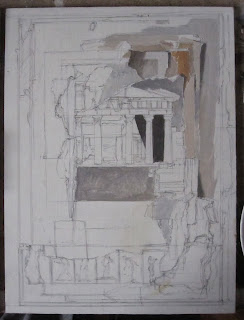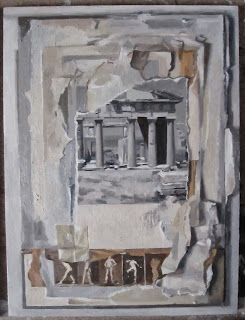Back from Venice after four days of autumn sunshine and a two hour delay returning due to thunder storm...
Despite being one of the most pictured cities in the world, reproduced endlessly in tourist itineraries and holiday snaps, now in the age of the iphone more than ever - being in this unique city with as many narratives as there are canals one can read the 'Stones of Venice' ( to quote Ruskin's famous work) as one moves through its closed dark and bright open spaces, and one is made aware of the importance of the sense of place and history to understanding the meaning of things.
Understanding the context as a work unfolds in time and space is crucial to the critical experience and engaging directly and in person with the work engenders an exchange and dialogue that is human in scale, has dimensions, is proportional, measured and balanced.
Being with the work matters.............
This is true of the many historical works by Tintoretto, Veronese, Titian, Bellini or Lotto that one encounters in situ in the churches and palaces they were designed for as well as for the contemporary artists whose work has been curated in the national pavilions and for the overarching theme of 'The Encyclopedic Palace' curated by Massimiliani Gioni. This is quoted from the text on the biennale website
The Exhibition draws inspiration from the model of a utopian dream by Marino Auriti who filed a design with the U.S. Patent office in 1955, depicting his Palazzo Enciclopedico (The Encyclopedic Palace), an imaginary museum that was meant to house all worldly knowledge. Auriti planned the model of a 136-story building to be built in Washington, in that would stand 700 meters tall and take up over 16 blocks.
“Auriti’s plan was never carried out, of course – Massimiliano Gioni says - but the dream of universal, all-embracing knowledge crops up throughout the history of art and humanity, as one that eccentrics like Auriti share with many other artists, writers, scientists, and self-proclaimed prophets who have tried—often in vain—to fashion an image of the world that will capture its infinite variety and richness. Today, as we grapple with a constant flood of information, such attempts to structure knowledge into all-inclusive systems seem even more necessary and even more desperate.”
Being with the work matters.
In Jesper Just's 'Intercourses' at the Danish Pavilion both the pavilion itself and the video installation explore the liminal spaces between ruin and construction. One experiences a sense of dislocation and displacement that challenges us to question both who, what and where we are.
http://www.kunst.dk/the-exhibition/
An overwhelming sense of the sheer physical materiality in both the waxy smell and the claustrophobic darkness seemed to absorb the viewer who entered Belgian pavilion. In 2012 the Flemish artist Belinda De Bruyckere and the South African writer J M Coetzee created in both a book, 'Allen Vlees' (All Flesh) and this work a testament to 'kindred spirits' to use the words of the artist. Hovering between life and death this giant sculpture of a horizontal bandaged 'cripple-wood' tree explores the body as a complex metaphor with profound historical resonance which touches a contemporary nerve and challenges the viewer to confront difficult existential questions.
http://www.belgianpavilion.be/
The Australian pavilion was the site for Simryn Gill's ' Here art grows on trees'. Simple circular found objects picked off the street and tiny delicate fragments of text collage on paper panels were left exposed to the weather and the effects of time in a roofless pavilion. Photographs of mines and a video of mangrove trees evoke the marginal zones of human and vegetal intervention and elemental existence between air, earth and water. The poetry of the ephemeral, the impermanent and the transient resonates in a city which like the mangroves occupies the zone between land and water and bears the marks of history and the passage of time.
The greatest art is perhaps timeless and universal but at the biennale it is difficult to ignore the zeitgeist.
Vadim Zakharov references the Greek myth of Danae as a poetical cipher to explore contemporary issues of gender, money, power, and corruption in an interactive performance installation in the Russian pavilion
Danae was the mother of the the Greek hero Perseus. Imprisoned by her father Acrisius to keep her childless because an oracle predicted he would be killed his daughter's son, she she was impregnated by Zeus who appeared in the form of golden rain. Patriarchy of both father and god, fear and desire, the corrupting or liberating power of money, divine intervention into mortal affairs and heroic action influence personal fate as it unfolds across generations in unexpected and tragic ways
The Greek pavilion, not surprisingly perhaps given the current financial crisis, hosted an exploration by Stefanos Tsivoploulos of value and money in ' History Zero'. With its gently ironic 'currency archive' and a series of three films the artist presents a mediated reality through the parallel lives of a migrant, an artist and an art collector whose different social and economic worlds intersect.
The Palasso Grassi hosted the work of Rudolf Stingel, a Italian artist based in New York, whose work reminded me of Gerhard Richter.
Large and small metallic paint abstractions and monochromatic photo-realist works exploited a rich web of painterly qualities of texture, pattern and gesture, often superimposed, in which the photograph or reproduction of a work of art functioned as the image. Interspersed over three floors they worked well juxtaposed against the baroque richness of the decorated coffered ceilings of the palace 'piano nobile' and the oversized carpeted installation that covered both walls and floors throughout the entire building with a slightly manic overindulgence and studied precision. The gilded splendour of the past colliding with the clinical white modernist spaces of the gallery as laboratory
Photography: mirror and image in contemporary painting.
This is the title of my research paper for presentation in mid November. I will make an initial brief examination of the work of four painters, Gerhard Richter, Luc Tuymans, Micheal Borremans and Peter Doig, as a point of departure for further investigations to support my ongoing studio practice.
Despite the crowds it is still possible to find silence and emptiness in Venice .......
 |
| Cimitero. Isole di San Michele |
 |
| Palazzo Grimani |
Cloister. Chiesa di San Francesco della Vigna
 |
| San Giorgio dei Greci |



















